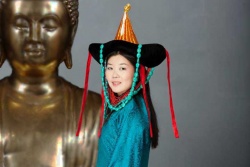Difference between revisions of "Rupavajra"
(Created page with "thumb|250px| The emptiness of form appearing in the form of an offering goddess. See; Great Treasury of Merit:, and Guide to ...") |
|||
| Line 1: | Line 1: | ||
[[File:5ghh78 n.jpg|thumb|250px|]] | [[File:5ghh78 n.jpg|thumb|250px|]] | ||
The [[emptiness]] of [[form]] appearing in the [[form]] of an [[offering]] [[goddess]]. | The [[emptiness]] of [[form]] appearing in the [[form]] of an [[offering]] [[goddess]]. | ||
| + | |||
| + | In [[Sakya]] we find four meanings of [[rDo-rJe]] ([[Vajra]]) | ||
| + | |||
| + | I. [[Dharmata]] [[Vajra]] | ||
| + | 2.Lakshana [[Vajra]] . | ||
| + | 3.Guhya [[Vajra]] and | ||
| + | 4. [[Rupa]] [[Vajra]] . | ||
| + | |||
| + | [[Dharmata]] [[Vajra]] is [[Sunyata]] itself. In [[Kanjur]] the question is posed:" You say [[Vajra]] [[Vajra]]. What you mean by [[Vajra]]?" and th15 answer is orrered "[[Vajra]] i.s hard, [[void]], imperishable, indestructable, which can not he cut, which can not be humt, that is, why it is callell [[Sunyata]] [[Vajra]]." In [[Tanjur]] a more predsedefinition is found : "[[Vajra]] is Dharmakayatmaka which is like [[Akasha]] ([[space]])." [[Lakshana]] [[Vajra]] that is the symhol of [[Vajra]] is made of {{Wiki|iron}}, bronze or some [[sacred]] metal. The [[form]] of the [[symbol]] may be with nine spokes, five spokes, three spokes and sometimes with even unclosed spokes. The spokes represent [[virtues]] and functions. In a [[Vajra]] with nine spokes, the central spoke stands for [[Dharmadhatu]]. A [[Vajra]] with five spokes represents the five Jinas or [[Buddhas]] in upper half and the five mother [[goddesses]] in lower half. | ||
| + | |||
| + | The [[five Buddhas]] are [[Vairocana]], [[Amoghasiddhi]], [[Akshobhya]], R.:ttnasambhava, and [[Amitabha]], that is the Five \Visdoms . The five [[deities]] are [[Mamaki]], [[Pandaravasini]], [[Tara]], [[Locana]], and [[Vajradhatvisvari]], that is the [[Five Elements]] . The two summits, called [[Dharmadhatu]], are the two vanishing points and thus also known as [[Sunyata]]. Tbe spokes are known to represent the horns ( x;. ) projecting from c,rocodile's {{Wiki|mouth}} and are regarded as instruments to draw out the [[sufferings]] of [[transmigration]]. The spine or centre of the [[Vajra]] consisting of the [[moon]] and eight [[lotus]] on either side of the [[moon]] is itself the sTon-pa-nid [[sunyata]]. The Secret [[Vajra]] as its [[name]] suggests has no known [[appearance]]. The Substantial [[Vajra]] is also a {{Wiki|matter}} more for [[meditation]] than for portrait. | ||
| + | |||
| + | [[Diamond]] has two names in [[Tibetan]]: [[rdo-rje]] rin-poche and rdo-rje-pha-lam , and in {{Wiki|hardness}} it is compared to the bones of Sho-thung that is [[Dadhichi]]. [[Hindu]] {{Wiki|legends}} describe [[Indra's]] weapon, [[thunder]] or [[thunderbolt]], as made of Dadhi-chi's bones. In [[Tibetan]] {{Wiki|legends}} and {{Wiki|literature}} rDorje is [[thought]] of in its [[material form]] as [[thunder]] or [[thunderbolt]]. I give below the extracts from [[Kanjur]], [[Tanjur]] and [[Sakya]] Kabum describing rDo-rJe as sTon-pa-nid or [[Sunyata]]. 42 | ||
See; [[Great Treasury of Merit]]:, and Guide to [[Dakini Land]]. | See; [[Great Treasury of Merit]]:, and Guide to [[Dakini Land]]. | ||
{{E}} | {{E}} | ||
[[Category:Vajra]] | [[Category:Vajra]] | ||
Revision as of 21:52, 17 February 2014
The emptiness of form appearing in the form of an offering goddess.
In Sakya we find four meanings of rDo-rJe (Vajra)
I. Dharmata Vajra 2.Lakshana Vajra . 3.Guhya Vajra and 4. Rupa Vajra .
Dharmata Vajra is Sunyata itself. In Kanjur the question is posed:" You say Vajra Vajra. What you mean by Vajra?" and th15 answer is orrered "Vajra i.s hard, void, imperishable, indestructable, which can not he cut, which can not be humt, that is, why it is callell Sunyata Vajra." In Tanjur a more predsedefinition is found : "Vajra is Dharmakayatmaka which is like Akasha (space)." Lakshana Vajra that is the symhol of Vajra is made of iron, bronze or some sacred metal. The form of the symbol may be with nine spokes, five spokes, three spokes and sometimes with even unclosed spokes. The spokes represent virtues and functions. In a Vajra with nine spokes, the central spoke stands for Dharmadhatu. A Vajra with five spokes represents the five Jinas or Buddhas in upper half and the five mother goddesses in lower half.
The five Buddhas are Vairocana, Amoghasiddhi, Akshobhya, R.:ttnasambhava, and Amitabha, that is the Five \Visdoms . The five deities are Mamaki, Pandaravasini, Tara, Locana, and Vajradhatvisvari, that is the Five Elements . The two summits, called Dharmadhatu, are the two vanishing points and thus also known as Sunyata. Tbe spokes are known to represent the horns ( x;. ) projecting from c,rocodile's mouth and are regarded as instruments to draw out the sufferings of transmigration. The spine or centre of the Vajra consisting of the moon and eight lotus on either side of the moon is itself the sTon-pa-nid sunyata. The Secret Vajra as its name suggests has no known appearance. The Substantial Vajra is also a matter more for meditation than for portrait.
Diamond has two names in Tibetan: rdo-rje rin-poche and rdo-rje-pha-lam , and in hardness it is compared to the bones of Sho-thung that is Dadhichi. Hindu legends describe Indra's weapon, thunder or thunderbolt, as made of Dadhi-chi's bones. In Tibetan legends and literature rDorje is thought of in its material form as thunder or thunderbolt. I give below the extracts from Kanjur, Tanjur and Sakya Kabum describing rDo-rJe as sTon-pa-nid or Sunyata. 42
See; Great Treasury of Merit:, and Guide to Dakini Land.
